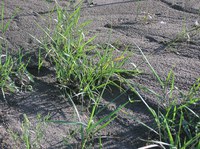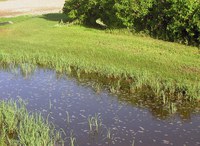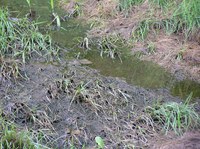NDSU Offers Tips on Repairing Flooded Lawns
(Click an image below to view a high-resolution image that can be downloaded)
The flood of 2011 has devastated many lawns across the state. As the floodwaters recede, the good news is that mid-August to mid-September is the best time to repair a lawn.
“The first step is to pick up any garbage and other debris the floodwaters brought into the yard,” says Tom Kalb, North Dakota State University Extension Service horticulturist. “Be careful because pieces of glass, metal and other harmful items may be buried in the silt. Clean up after working with the soil because it may have been contaminated with toxic materials.”
Lawns under water for less than four days and covered with 1 inch or less of silt may recover quickly. In this case, gently rake the ground to break the soil crust. Core aeration can help dry the soil. A half-strength fertilizer application of 1/2 pound of nitrogen per 1,000 square feet will encourage turf recovery. Overseeding this fall may thicken the lawn.
Lawns underwater for more than four days and/or covered with more than 1 inch of silt will require major renovation. Much, if not all, of the turf is dead.
“Start by grading the landscape and trying to get it back to its original topography as much as possible,” says Kalb. “Accumulations of silt greater than 3 inches should be scraped away. Severely eroded areas should be replenished with topsoil. As a general rule, at least 4 inches of topsoil is needed for a healthy lawn.”
Cultivate the area and incorporate the silt into the topsoil. Prepare a smooth seedbed and apply a starter fertilizer.
“Seeding is best done from mid-August to mid-September,” Kalb says. “Spring is the second best time of the year. Use hardy grass types normally used in our region, such as Kentucky bluegrass, red and other fine fescues, perennial ryegrass, crested wheatgrass and blue grama grass. Flood-tolerant grasses, such as reed canary grass, are too coarse and not recommended for home landscapes.”
New sod can be applied through mid-October. The sod typically is a mix of Kentucky bluegrass that should be used only in sunny areas.
“Your lawn is one of the toughest, most adaptable components of a home landscape,” Kalb says. “Give it some attention this fall and you can enjoy a healthy, attractive lawn next year.”
For more information, see the NDSU publication ""Home Lawn Establishment"" at http://www.ag.ndsu.edu/pubs/plantsci/landscap/h1311.pdf.
NDSU Agriculture Communication
| Source: | Tom Kalb, (701) 221-6865, tom.kalb@ndsu.edu |
|---|---|
| Editor: | Rich Mattern, (701) 231-6136, richard.mattern@ndsu.edu |




